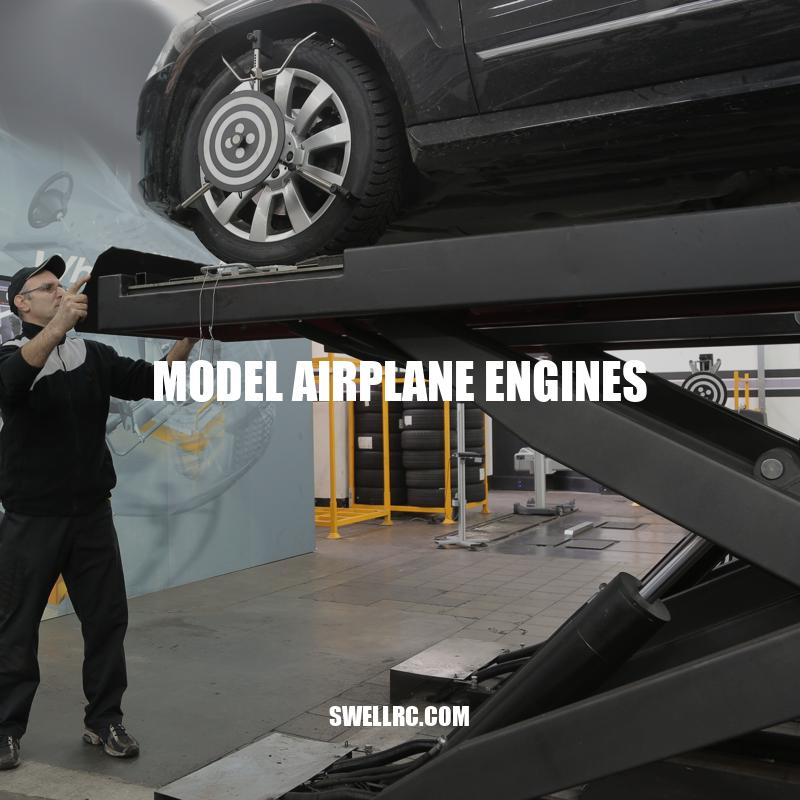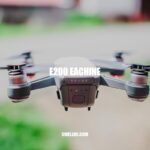Model Airplane Engines: A Comprehensive Guide
Model airplane engines are the driving force behind every remote controlled flying machine, and they play an essential role in determining the performance and experience of the pilot and enthusiast. Model airplane engines are designed to power small, lightweight aircraft and are available in a variety of sizes and types. From gasoline-powered machines to electric and glow-powered models, each type of engine has its own unique set of advantages and disadvantages that make it well suited for different uses.
Gasoline-powered engines are known for their power and require actual gasoline to operate. They run on a mixture of gasoline and oil that is burned in the engine’s cylinder to power the motor. Gas-powered engines are typically larger and heavier than their electric-powered counterparts, but they offer unparalleled performance and are well-suited for larger aircraft or those intended for aerobatic flying. On the other hand, electric-powered engines are powered by batteries and run on electricity. They are generally lighter and smaller than gas-powered engines, making them a popular choice for racing and acrobatic flying. Electric motors are also reliable, require less maintenance, and are quieter. Additional benefits include lower operating costs and the ability to fly in more noise-sensitive areas. Finally, there are glow-powered engines, which use a nitromethane-based fuel that’s burned to create power. They are known for their simple yet reliable operation, which makes them popular among beginners. Glow engines are typically used in smaller aircraft and require routine maintenance and upkeep.
Types of Model Airplane Engines
There are various types of model airplane engines available on the market. Some of the most common types include:
- Two-Stroke Gasoline Engines: These engines run on a two-stroke cycle and require a fuel mixture of gasoline and oil. They are lightweight, powerful, and easy to maintain. Examples include the DLE-20 and EME 35, which are popular among remote control airplane enthusiasts.
- Four-Stroke Gasoline Engines: These engines are more fuel-efficient and produce less noise than the two-stroke engines. They are used in larger model aircraft and require little maintenance. Good examples include the Saito FG-60R3 and Saito FG-90R3 engines, which are well known in the industry due to their exceptional performance.
- Electric Motors: These engines are powered by batteries and run on electricity. They are lightweight, reliable, and produce less noise than gasoline-powered engines. Examples of electric motors include the E-flite Power 160 and Castle Creations Phoenix Edge HV 160, which are popular among remote control enthusiasts who fly larger-sized aircraft.
- Glow Engines: These engines have been popular among model airplane enthusiasts for decades. They use nitromethane fuel and a battery-powered glow plug to spark ignition. Examples of good-quality glow engines include the Saito FA-180B and O.S. Engines O.S .46AX II , which are both highly-praised by experienced model airplane enthusiasts.
Table: Comparison of Types of Model Airplane Engines
| |Gasoline Engines |Electric Motors |Glow Engines |
|——————————-|——————|——————|——————–|
|Fuel |Gasoline and oil |Batteries |Nitromethane-based |
|Power |Powerful |Less powerful |Moderate to powerful|
|Weight |Heavier |Lighter |Moderate |
|Noise level |Loud |Quiet |Loud |
|Maintenance requirements |Moderate |Low |Moderate to high |
|Suitable for aerobatic flying? |Yes |No |Yes, with some types |
|Operating cost |High |Low |Moderate |
When shopping for a model airplane engine, it is also important to consider the brand and the type of aircraft with which it is compatible. Some of the best brands to look out for include Saito, O.S. Engines, EME, and Castle Creations. Additionally, you can check out websites such as HobbyKing, Tower Hobbies, and Horizon Hobby, where you can find an extensive collection of model airplane engines and accessories to help you find the perfect fit for your needs.
What types of engines are on planes?
There are several types of engines used on planes. The most common are:
- Turbofan engines: used in almost all commercial airliners
- Turboprop engines: commonly used in smaller planes for short-haul flights
- Turbojet engines: used in military aircraft and some early commercial jets
- Rocket engines: used in some experimental aircraft, spacecraft, and missiles
Each type of engine has its own advantages and disadvantages in terms of efficiency, speed, and power. To learn more about the specifics of each type of engine, you can check out aviation websites like Aviation Week or the Federal Aviation Administration.
Factors to Consider When Choosing a Model Airplane Engine
Choosing the right model airplane engine is crucial for the performance and safety of your model aircraft. Here are some factors to consider:
- Size and Weight: Consider the weight and size of your model airplane. A heavy or oversized engine may negatively impact the performance of your aircraft.
- Power Output: The power output of your engine should be sufficient to power your aircraft. Choose an engine with an output that matches your aircraft’s power requirements.
- Compatibility: The engine should be compatible with your model aircraft. This includes the type of fuel it requires, its physical size, and its mounting options.
- Fuel Requirements: Different engines require different types of fuel such as gasoline, nitromethane, or electric. Choose an engine that is compatible with the type of fuel you are willing to use.
- Budget: Model airplane engines vary in price, which may influence your decision. Determine how much you are willing to spend and choose an engine that fits your budget while still meeting your requirements.
It is also essential to note that different types of engines are suitable for different types of flying. For instance, electric motors are excellent for beginners learning to fly and for flying indoors due to their quiet nature. On the other hand, gasoline engines are powerful and are suitable for aerobatic flying due to their high power output. Glow engines are best for scale flying, while turbines are mostly used in advanced models and are expensive.
Table: Comparison of Model Airplane Engines
| |Gasoline Engines|Electric Motors|Glow Engines|
|——————-|—————-|—————|————|
|Fuel Efficiency |Moderate to high|High |Moderate |
|Power Output |High |Low to moderate|Moderate to high|
|Weight |Heavier |Light |Moderate to heavy|
|Noise level |Loud |Quiet |Moderate to loud|
|Maintenance |Moderate |Minimal |Moderate to high|
|Price |Moderate to high|Moderate to high|Moderate to high|
When looking to buy a model airplane engine, you can check out manufacturer websites, such as Saito Engines, and dealer websites like Tower Hobbies, to gain insight into the specifications of different types of engines and their compatibility with different aircraft models.
How do I choose a motor for my RC plane?
Choosing the right motor for your RC plane is crucial for its performance. Here are some factors you should consider before making a purchase:
- Weight: The weight of the motor should be suitable for the weight of your plane. A heavier motor can affect the balance and stability of your plane.
- Power: The power of the motor should match the size and weight of your plane. Too little power can result in sluggish performance, while too much power can cause damage to your plane.
- Thrust: The thrust of the motor should be sufficient for your plane to reach the desired speed and altitude.
- Battery: The motor and battery should be compatible. Check the voltage and capacity ratings to ensure they match.
- ESC: The Electronic Speed Controller (ESC) should be able to handle the current rating of the motor.
You can use online calculators such as eCalc or DriveCalc to determine the right motor for your plane. You can also check out websites like HobbyKing and Tower Hobbies for a variety of motors to choose from.
Glow-powered Model Airplane Engines
Glow-powered engines use a mixture of methanol, nitromethane, and oil, which ignites when exposed to a platinum element in the engine’s glow plug. These types of engines emit a pleasant smell due to the nitromethane content, and they are ideal for those who want to achieve a realistic sound and throttle response. Here are some advantages and disadvantages of using glow-powered model airplane engines:
- Advantages:
- More reliable than other types of engines.
- Provides true sound and throttle response.
- Cool sound and smoke can be achieved by using the right mixture of fuel and oil.
- Easy to adjust and tune.
- Less expensive than gas-powered engines.
- Disadvantages:
- Requires a glow plug to ignite the fuel mixture, which can be challenging to replace and set up correctly.
- Produces a moderate to high level of noise.
- Oil content in fuel can negatively impact the environment and discolor the aircraft’s exterior.
- More cleaning and maintenance required compared to electric motors.
Glow-powered engines are widely available and can be purchased from various websites, including Horizon Hobby, RC Planet, and many more. These engines typically come with a manual that outlines the necessary steps for set up and maintenance. However, it is critical to follow the instructions carefully to prevent accidents and maintain the engine’s performance in the long run.
Glow Plug Types Comparison Table
A crucial part of glow-powered engines is the glow plug, which works by providing heat to ignite the fuel mixture. There are various types of glow plugs available that work well depending on different situations. Here is a comparison table of the different types of glow plugs:
| Glow Plug Type | Application |
|---|---|
| Standard | For initial engine break-in. |
| Hot | Used when starting aircraft in cold weather. |
| Medium | For warmer weather and higher nitro content. |
| Cold | Adapted to run on reacher fuel with lower nitro. |
| Turbo | For high-performance 2-cycle or 4-cycle engines. |
It is essential to choose the right kind of glow plug depending on the engine type, weather, and fuel used, among others.
What is the fuel in glow plug model engine?
The fuel for a glow plug model engine is usually a blend of methanol, nitromethane, and oil. The exact ratio of these components depends on the manufacturer and the intended use of the engine. Methanol provides the majority of the fuel’s energy, while nitromethane helps to boost power and performance. Oil is added to lubricate the engine components and prevent wear and tear. It’s important to use the right fuel for your engine to ensure optimal performance and longevity.
For more information on glow plug model engines and fuel, you can check out hobby websites like RC Planet or towerhobbies.com. These sites offer a variety of resources, including forums, product reviews, and how-to guides, that can help you get the most out of your model engine.
Tips for Choosing the Right Model Airplane Engine
Choosing the right model airplane engine is critical to the performance and success of your model airplane. Here are some tips to help you make the best choice:
- Engine Size: Consider the size and weight of your model airplane when choosing an engine. An engine that is too large or too small can negatively impact the aircraft’s stability and performance.
- Power Output: The power output of the engine should match the model airplane’s weight and intended use. A higher power output does not always translate to better performance if the engine is too heavy for the aircraft or causes instability.
- Compatibility: Ensure that the engine you choose is compatible with your model airplane in terms of the mounting pattern, fuel type, and required space for installation.
- Type of Engine: Consider the different types of engines available and their advantages and disadvantages to determine which one is best suited for your needs and budget.
- Noise: If you plan to fly your model airplane in residential areas or have noise restrictions, consider an electric motor or a gas-powered engine with a muffler.
- Brand and Quality: Invest in a reputable and quality brand of engine that will last longer and perform better in the long run. Research online reviews and user experiences for insights.
Online hobbies and model airplane stores such as Tower Hobbies and HobbyKing offer an extensive selection of model airplane engines for purchase. It is essential to refer to the manufacturer’s recommendations and manuals for proper installation and maintenance of the engine. By taking the time to select the right engine and correctly maintaining it, you can ensure a successful and enjoyable flight every time.
How do I choose an ESC for my RC plane?
When choosing an Electronic Speed Controller (ESC) for your RC plane, there are several factors to consider:
- Amps rating: Ensure that the ESC is capable of handling the maximum amps required by your motor and battery.
- BEC voltage: Check if the ESC has a Battery Eliminator Circuit (BEC) and if it is compatible with your receiver’s voltage requirement.
- Programming options: Some ESCs offer programming options like brake, timing, and throttle curve that can improve the performance of your plane. Consider if these options are important to you.
- Size and weight: Choose an ESC that is suitable for the size and weight of your plane.
Some popular ESC brands for RC planes include Castle Creations, Hobbywing, and EMAX. You can also find a variety of ESC options on websites like Amazon, RC Planet, and Horizon Hobby.
Here’s a comparison table of ESCs that can help you make an informed decision:
| Brand | Amps rating | BEC voltage | Programming options | Size and weight |
|---|---|---|---|---|
| Castle Creations | Up to 120A | 5-7.4V | Yes | Various options available |
| Hobbywing | Up to 60A | 5-7.4V | Yes | Various options available |
| EMAX | Up to 40A | No BEC | No | Compact and lightweight |
Maintenance and Troubleshooting for Model Airplane Engines
Keeping your model airplane engine in top condition is crucial for optimal performance and longevity. Here are some tips for maintaining and troubleshooting your model airplane engine:
- Cleaning: Regularly clean the engine, including the carburetor, air filter, and fuel tank to prevent clogging and dirt buildup.
- Fuel: Use the recommended type of fuel for your engine and prevent old or contaminated fuel from entering the engine.
- Spark Plug: Regularly check and replace the spark plug as needed, usually after every few flights.
- Bearings: Check the bearings for wear and tear and lubricate them regularly.
- Temperature: Avoid running your engine at high temperatures as it can cause damage and decrease performance.
- Start-up: Always follow the manufacturer’s instructions for starting up and shutting down your model airplane engine.
- Troubleshooting: Refer to the manufacturer’s manual and online forums such as RC Groups and RC Universe for common issues and their solutions, such as engine not starting, low-power output, or overheating.
Several online tutorials and forums such as RC Groups and RC Universe offer valuable insights and expertise for maintaining and troubleshooting model airplane engines. Additionally, model airplane hobby stores and websites like Horizon Hobby and Motion RC offer spare parts and replacement components for your engine, ensuring that you have everything you need to keep your model airplane flying high.
What are the aircraft engine maintenance practices?
Aircraft engine maintenance practices are crucial to ensure the safe and efficient operation of aircraft engines. Here are some of the common best practices:
- Perform regular inspections of the engine and its components to detect signs of wear, damage, or malfunction.
- Monitor engine temperatures, pressures, and other parameters to ensure that they remain within the operational limits.
- Clean the engine regularly to prevent the buildup of dirt, dust, and debris which can cause damage and reduce efficiency.
- Replace worn or damaged parts as soon as possible to prevent further damage and ensure the engine’s optimal performance.
- Follow the manufacturer’s recommended maintenance schedule and procedures to keep the engine in good condition and avoid unnecessary downtime or repairs.
For more detailed information and resources on aircraft engine maintenance practices, you can check out the FAA’s website or consult with a trusted aviation maintenance provider such as GE Aviation.
Conclusion
Model airplane engines are crucial components that power these miniature flying machines. Before choosing an engine, consider the size, weight, and power output requirements for your model airplane and determine which engine type is suitable for your needs. Gas-powered engines are powerful and offer great performance, but they require more maintenance and have higher operating costs than electric or glow-powered engines.
Electric-powered engines are efficient and low-maintenance, but their flight time and power output are limited compared to gas-powered engines. Glow-powered engines offer a good balance of power and efficiency but require more skill and expertise to operate.
Regardless of the engine type you choose, proper maintenance and troubleshooting are crucial for keeping your model airplane engine in top condition and ensuring optimal performance. Take advantage of the resources and spare parts available through online forums and hobby stores to keep your engine running smoothly.
In summary, model airplane engines are a crucial component that can have a significant impact on the performance and flight experience of your model airplane. Choose wisely, follow proper maintenance and troubleshooting techniques, and, most importantly, have fun flying your model airplane!



